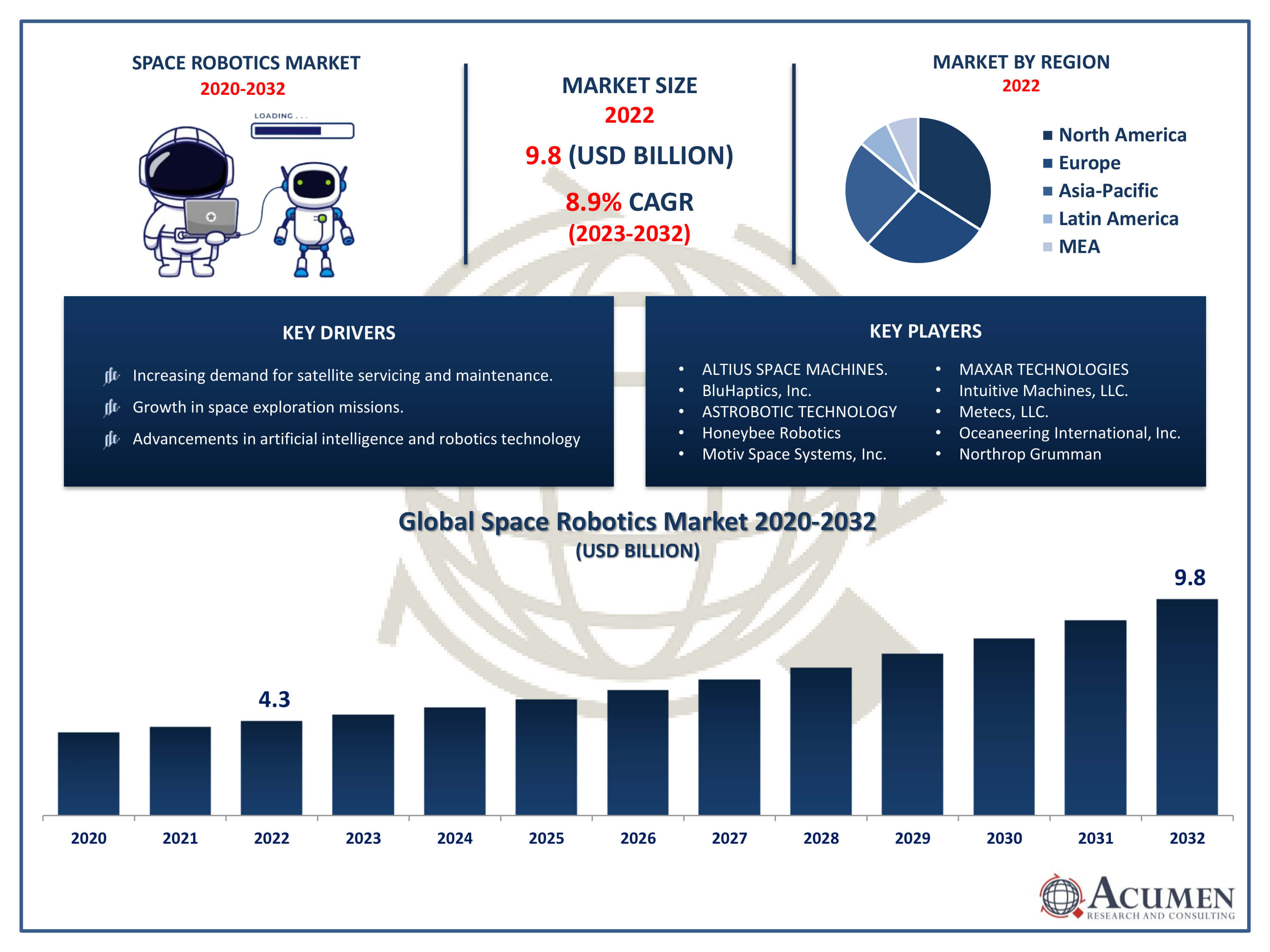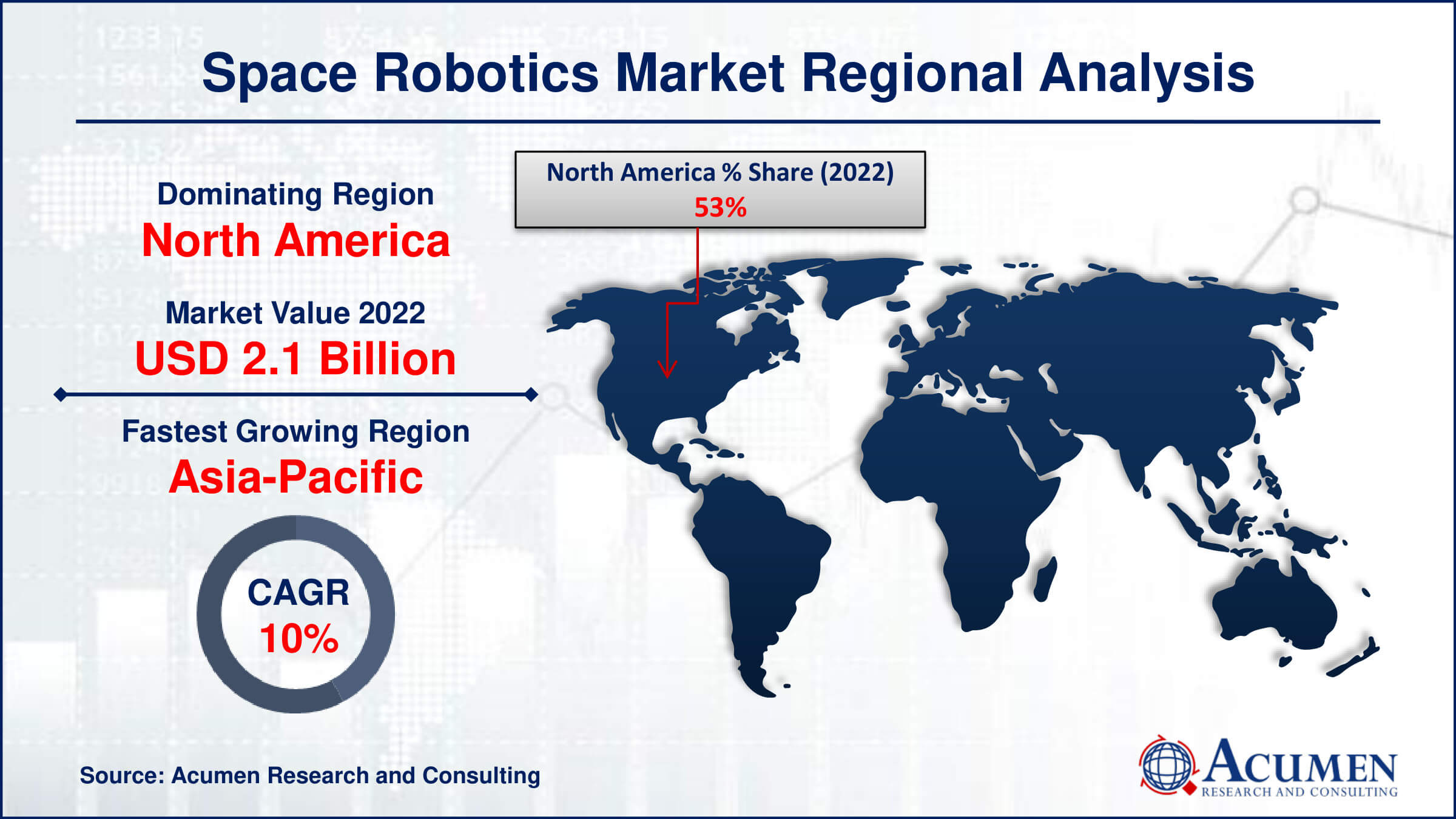May 2020
Space Robotics Market Size accounted for USD 4.3 Billion in 2022 and is projected to achieve a market size of USD 9.8 Billion by 2032 growing at a CAGR of 8.9% from 2023 to 2032.
The Space Robotics Market Size accounted for USD 4.3 Billion in 2022 and is projected to achieve a market size of USD 9.8 Billion by 2032 growing at a CAGR of 8.9% from 2023 to 2032.
Space Robotics Market Highlights

Space robotics refers to the use of robotic systems in outer space for various applications, including exploration, maintenance, servicing, and assembly of spacecraft, satellites, and other celestial objects. These robotic systems are designed to operate in the harsh conditions of space, where human presence is challenging or not feasible. Space robotics can include autonomous or remotely controlled robots, rovers, and robotic arms equipped with specialized tools and sensors to perform tasks such as repairing satellites, collecting samples from celestial bodies, or assembling structures in space.
The market for space robotics has been experiencing significant growth in recent years, driven by the increasing demand for satellite servicing, exploration missions, and the development of space infrastructure. As the space industry continues to expand with the involvement of private companies and government initiatives, there is a growing need for efficient and cost-effective solutions for space operations. The use of robotics in space not only enhances the capabilities of space missions but also reduces the risks and costs associated with human spaceflight. With advancements in technology, the space robotics market is expected to witness continued growth, offering new opportunities for companies specializing in robotic technology for space applications.
Global Space Robotics Market Trends
Market Drivers
Market Restraints
Market Opportunities
Space Robotics Market Report Coverage
| Market | Space Robotics Market |
| Space Robotics Market Size 2022 | USD 4.3 Billion |
| Space Robotics Market Forecast 2032 | USD 9.8 Billion |
| Space Robotics Market CAGR During 2023 - 2032 | 8.9% |
| Space Robotics Market Analysis Period | 2020 - 2032 |
| Space Robotics Market Base Year |
2022 |
| Space Robotics Market Forecast Data | 2023 - 2032 |
| Segments Covered | By Solution, By Organization Type, By Application, And By Geography |
| Regional Scope | North America, Europe, Asia Pacific, Latin America, and Middle East & Africa |
| Key Companies Profiled | ALTIUS SPACE MACHINES., BluHaptics, Inc., ASTROBOTIC TECHNOLOGY, Honeybee Robotics, Motiv Space Systems, Inc., MAXAR TECHNOLOGIES, Intuitive Machines, LLC., Metecs, LLC., Oceaneering International, Inc., and Northrop Grumman. |
| Report Coverage |
Market Trends, Drivers, Restraints, Competitive Analysis, Player Profiling, Covid-19 Analysis, Regulation Analysis |
Space robotics encompasses a range of technologies, including autonomous robots, robotic arms, and rovers, each equipped with specialized tools and sensors to execute tasks such as satellite servicing, space exploration, maintenance, and assembly of structures in space. The deployment of space robotics enables more efficient and cost-effective solutions for space missions while minimizing the risks associated with human spaceflight. Applications of space robotics are diverse and crucial for advancing our capabilities in outer space. One significant application is satellite servicing, where robotic systems are employed to extend the operational life of satellites by repairing or refueling them. Space exploration missions also heavily rely on robotics, with rovers like those used on Mars, such as NASA's Curiosity and Perseverance, exploring the surface of celestial bodies.
The space robotics market has been experiencing robust growth in recent years, driven by a confluence of factors that underscore the increasing importance of robotic systems in space exploration and satellite operations. The rising number of satellite launches for communication, Earth observation, and navigation purposes has created a heightened demand for space robotics, particularly in satellite servicing and maintenance. Companies are increasingly investing in developing robotic solutions to extend the lifespan of satellites, perform repairs, and upgrade functionalities, contributing significantly to the growth of the space robotics industry. Furthermore, the ongoing exploration of outer space, both by government space agencies and private companies, has spurred innovation in space robotics. Rovers and robotic arms are crucial components of missions to celestial bodies, conducting experiments, collecting samples, and assisting in scientific discoveries. As these exploration missions become more frequent and diverse, the demand for advanced robotic systems capable of navigating challenging terrains and executing complex tasks in space environments continues to rise.
Space Robotics Market Segmentation
The global Space Robotics Market segmentation is based on solution, organization type, application, and geography.
Space Robotics Market By Solution
According to the space robotics industry analysis, the remotely operated vehicles (ROV) segment accounted for the largest market share in 2022. ROVs play a pivotal role in various space missions, particularly in satellite servicing and maintenance tasks. As the number of operational satellites in Earth's orbit continues to increase, there is a growing need for robotic systems like ROVs to perform maintenance, repairs, and upgrades. The ability of ROVs to conduct intricate and precise operations in space, guided by operators on Earth, makes them indispensable for extending the lifespan and optimizing the functionality of satellites. The increasing complexity of space exploration missions has also contributed to the growth of the ROV segment. Whether deployed on the Moon, Mars, or other celestial bodies, ROVs provide a valuable means of conducting experiments, collecting samples, and performing tasks that require dexterity and precision.
Space Robotics Market By Organization Type
In terms of organization types, the commercial segment is expected to witness significant growth in the coming years. This growth is propelled by the increasing involvement of private companies in space exploration and satellite services. Traditionally dominated by government space agencies, the commercialization of space activities has opened up new opportunities for businesses to participate in a range of space-related ventures. Private companies are actively investing in space robotics to provide innovative solutions for satellite servicing, maintenance, and exploration, driving the expansion of the commercial segment. One key driver for the growth of the commercial space robotics segment is the burgeoning satellite industry. With a surge in the number of satellites for communication, Earth observation, and navigation, commercial entities are developing robotic systems to address the growing demand for satellite deployment, servicing, and end-of-life disposal.
Space Robotics Market By Application
According to the space robotics market forecast, the deep space segment is expected to witness significant growth in the coming years. Deep space robotics plays a pivotal role in extending human reach into the cosmos, with applications ranging from planetary exploration to interplanetary probes. Rovers equipped with advanced robotic systems are deployed to celestial bodies like Mars to conduct experiments, analyze soil samples, and provide critical data for scientific research. The growth of the deep space segment is closely tied to the aspirations of space agencies to explore and understand the mysteries of our solar system and beyond. One of the significant contributors to the growth of the deep space segment is the increasing interest in lunar exploration. Governments and private companies alike are investing in robotic technologies to enable the exploration and potential utilization of resources on the Moon.
Space Robotics Market Regional Outlook
North America
Europe
Asia-Pacific
Latin America
The Middle East & Africa

Space Robotics Market Regional Analysis
North America has emerged as a dominant force in the space robotics market, driven by a combination of technological prowess, robust government initiatives, and the presence of leading private aerospace companies. The United States, in particular, has been a trailblazer in space exploration, with NASA (National Aeronautics and Space Administration) playing a pivotal role in shaping the industry. The strong foundation laid by NASA, coupled with strategic collaborations between the government and private sector entities, has propelled North America to the forefront of space robotics development and deployment. Private companies such as SpaceX, Blue Origin, and Northrop Grumman, among others, have significantly contributed to the region's dominance in the space technology market. These companies are at the forefront of innovation, investing heavily in the research and development of advanced robotic systems for various space applications. The entrepreneurial spirit and the ability to attract substantial investment have enabled North American companies to lead in areas such as satellite servicing, autonomous space exploration, and in-space assembly. Additionally, the commercialization of space activities in North America has created a vibrant ecosystem, fostering competition and collaboration, further solidifying the region's position as a driving force in the global space robotics market.
Space Robotics Market Player
Some of the top space robotics market companies offered in the professional report include ALTIUS SPACE MACHINES., BluHaptics, Inc., ASTROBOTIC TECHNOLOGY, Honeybee Robotics, Motiv Space Systems, Inc., MAXAR TECHNOLOGIES, Intuitive Machines, LLC., Metecs, LLC., Oceaneering International, Inc., and Northrop Grumman.
Looking for discounts, bulk pricing, or custom solutions? Contact us today at sales@acumenresearchandconsulting.com
May 2020
July 2020
November 2018
September 2020